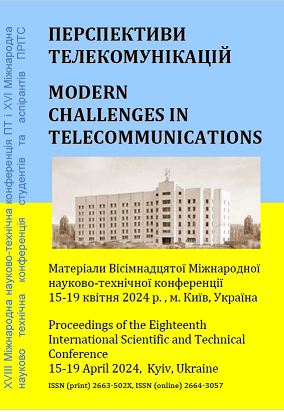МЕТОДИ КЛАСТЕРІЗАЦІЇ В БЕЗПРОВОДОВИХ СЕНСОРНИХ МЕРЕЖАХ НАСТУПНОГО ПОКОЛІННЯ
Ключові слова:
БЕЗПРОВОДОВА СЕНСОРНА МЕРЕЖА, КЛАСТЕРІЗАЦІЯАнотація
Бездротові сенсорні мережі (WSN) є життєво важливими для різноманітних застосувань, але їх ефективність значною мірою залежить від методів кластеризації. У цьому огляді розглядаються останні інновації в кластеризації для WSN наступного покоління, наголошуючи на енергоефективності, масштабованості, адаптивності, балансуванні навантаження, безпеці та гетерогенності вузлів. Враховуючи ці фактори, сучасні методи кластеризації спрямовані на продовження терміну служби мережі, оптимізацію передачі даних і забезпечення надійної продуктивності. Цей огляд містить цінну інформацію для дослідників і практиків у сфері бездротового зв’язку та сенсорних мереж.
Посилання
Heinzelman, Wendi B., Anantha P. Chandrakasan, and Hari Balakrishnan. "Energy-efficient communication protocol for wireless microsensor networks." Proceedings of the 33rd annual Hawaii international conference on system sciences. 2000.
Lindsey, Scott, and Cauligi S. Raghavendra. "PEGASIS: Power-efficient gathering in sensor information systems." Aerospace conference proceedings, 2002. IEEE, 2002.
Manjeshwar, Arati, and Dharma P. Agrawal. "TEEN: a routing protocol for enhanced efficiency in wireless sensor networks." Distributed Computing Systems Workshops, 2001. Proceedings. 2001 International Conference on. IEEE, 2001.
Abbasi, Abdul R., and Mohamed Younis. "A survey on clustering algorithms for wireless sensor networks." Computer communications 30.14-15 (2007): 2826-2841.
Yu, Honghai, et al. "LEACH-C: A clustering protocol for wireless sensor networks." Sensors 9.5 (2009): 3800-3817.
##submission.downloads##
Опубліковано
Як цитувати
Номер
Розділ
Ліцензія

Ця робота ліцензується відповідно до Creative Commons Attribution 4.0 International License.
Authors who submit to this conference agree to the following terms:a) Authors retain copyright over their work, while allowing the conference to place this unpublished work under a Creative Commons Attribution License, which allows others to freely access, use, and share the work, with an acknowledgement of the work's authorship and its initial presentation at this conference.
b) Authors are able to waive the terms of the CC license and enter into separate, additional contractual arrangements for the non-exclusive distribution and subsequent publication of this work (e.g., publish a revised version in a journal, post it to an institutional repository or publish it in a book), with an acknowledgement of its initial presentation at this conference.
c) In addition, authors are encouraged to post and share their work online (e.g., in institutional repositories or on their website) at any point before and after the conference.

